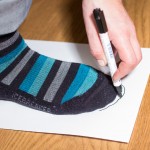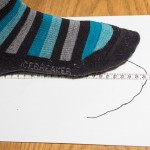Contents
- As is so often the case with shoes, there is no internationally valid system according to which sizes are determined. The measurement methods also have no uniform standard. Four different sizes have been adopted worldwide, which makes things a little more manageable compared to clothing.
- Measuring foot length: Instructions & size chart
- Shoe Size Basics
- Mondopoint, European, English and American shoe sizes
- Footwear size chart at Bergzeit
- Shoe size chart Men
- Shoe size chart Women
- Shoe size chart Children
- Size chart Ski Boots
- If the shoe fits: there's only one way to know…. try it on
Long and the short of it
- Your own foot length is all you need when buying shoes. Note: Both feet must be measured! (More on this…)
- Worldwide there are four different systems for shoes in regard to Mondopoint, EU-, UK- and US-sizes. (More on this…)
- Keeping in mind that every manufacturer uses a different last in regard to toe height, toe shape and width, there’s only one sure way to know if the shoe fits and that’s to try the shoe on. (More on this…)
In detail
Similar to clothing, choosing the right size shoe isn’t easy. Numbers and letters can be hard to decipher and even with your own foot length, it’s far from guaranteed that the shoe will fit.
- Shoe size basics
- Overview of shoe size systems
- Foot length measurements (photo instructions)
- Shoe size chart men
- Shoe size chart women
- Size chart kid’s shoes
- Size chart ski boots
- Fit and Style
As is so often the case with shoes, there is no internationally valid system according to which sizes are determined. The measurement methods also have no uniform standard. Four different sizes have been adopted worldwide, which makes things a little more manageable compared to clothing.
Measuring foot length: Instructions & size chart
Knowing your own foot length is essential when purchasing shoes. The foot size and inner length must be distinguished:
- The foot size is the actual measured foot size
- The inner length is truly the inner length of the shoe. This is usually 15 millimetres longer than the foot size.
It’s important to measure both feet, as differing sizes in feet are more the norm in humans than the exception:
- Step 1: The larger foot is placed on a blank sheet of paper. Ensure that heel and paper margin up exactly the same, so it’s best to perform against a wall or a piece of furniture.
- Step 2: With a pencil trace the shape of the foot in front of the toes
- Step 3: Now you can accurately determine the foot length on the edge of the paper from the heel up to the longest toe.
In general, it can be summed up that knowing one’s foot length is an important factor when buying shoes. When referring to the shoe size charts, take the larger sized foot as measurement. More detailed instructions can be found in the photos below. The attached size chart for men, women, children and ski boots will assist you when converting.
What to look for in selecting a size for running shoes, hiking or trekking boots or climbing shoes
- Casual/leisure shoe: Here, as a rule, 10-15 millimetres is sufficient.
- Running shoe: For running and trail running shoes, there should be approx. 15-20 millimetres of space at the front.
- Hiking/trekking boot: Toes should have some room, again, similar to running shoes, leave 15-20 millimetres at the front.
- Climbing shoes: Climbing shoes are a special case: the foot size and inside of the shoe are usually identical.
Shoe Size Basics
Tracing your footprint alone, certainly won’t determine your shoe size. Depending on where you measure, the length can vary. Finding suitable footwear is determined greatly by width, the height of the instep, the general shape of the foot and other individual factors.
For this reason, most sport and outdoor shoes use the last length as a basis for shoe sizes. This takes into account the assumed foot length with a further 1.5 to two centimetres added at the front near the toes – the exact measurements, however, depend on the shoe’s shape, the height of the heel and again, will vary from manufacturer to manufacturer. Also, there are very few manufactures that take width (mainly for economic reasons) into consideration. The width is usually proportional and only in exceptional cases – for example, Hanwag – make wide or narrow versions of the same shoe model.
Mondopoint, European, English and American shoe sizes
The length of the last alone does not determine the shoe size. There are typically four different systems that chart the last e.g. foot and shoe size:
- Mondopoint (MP): Foot length and width are the reference points of the Mondopoint system. The measurements are done in metric – millimetres or centimetres. Because of its accuracy, this system is used by the military and for measuring ski boots. The length specification for Freeride ski boots is measured without the width and in 0.5-centimetre increments. Meaning a foot measurement with a true length of 27.5cm corresponds with an MP 27.5.
- European sizes: The European shoe size refers to the length of the last, expressed in “Paris points”, for both sexes and for adults and children alike. As a unit of measurement for shoemakers, the “Paris Points has its roots from as early as 1800 in France. Because a Paris point calculates to 0.667 centimetres in length (2/3 centimetre = a Parisian point), It’s easier to calculate the last length in centimetre multiplied by 1.5. Meaning the last length of 27.5 centimetres would show a shoe size of 41.25. As Europe specifies only half sizes, this would round off the shoe size to a European 41.5 shoe size. Occasionally a size 41 1/3 or 2/3 will show. This results from the conversion of UK or US sizes.
- UK sizes (British / English shoe sizes): In the UK and North America shoe sizing corresponds to 1/3 inch with the measurement unit being “barleycorn”. Unlike Mondopoint or European shoe size, this sizing system starts at the smallest deemed size which is called “zero and measured both for children, women and men’s shoes. The calculated UK shoe size for adults is measured by multiplying the last length by 3 in inches minus 25 (3 x last length in inches) – 25. Children’s shoe sizes are calculated by subtracting 12 (3 x last length in inches) – 12. It sounds more complicated than it is: The last length of 27.5 centimetres converts to 10.83 inches (divided by 2.54). Multiply that by three gives 32.46, minus 25 calculates to a UK 7.5 shoe size (rounded off).
- US sizes: With two common methods of measurement, as well as the zero point sizing, being measured differently for men, women & children, the U.S.A shoe sizes certainly make things even more complicated. In addition, some manufacturers, use the foot length and other last lengths as a fundamental value. A detailed list of formulas is beyond the realms of this overview, in the size charts, all relevant Bergzeit US companies have been listed separately.
Footwear size chart at Bergzeit
At Bergzeit you’ll find the direct size charts for individual brands and their individual products – as we are able to provide them.
If the shoe fits: there’s only one way to know…. try it on
The foot length per Se is relatively easy to measure, but depending on the shape of the foot, it’s still difficult to figure out whether it’s a perfect fit. Determining whether your foot is suitable for a certain outdoor shoe brand will still depend on the height of your instep, foot width and toe form and by trying on the shoe is ultimately the only way to know whether it truly fits. As to whether a shoe fits, depends greatly on the intended purpose of the shoe and how much room is required. More information can be found in our buyer’s guides or product reviews.
More helpful tips and info on buying shoes and boots
- Children’s winter boots: A buyer’s guide
- How to find the sole length on your ski boot
- What is a Mondopoint and how to find your ski boot size






